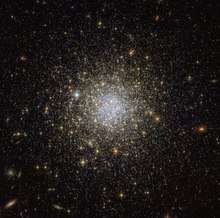NGC 1466
NGC 1466 is the New General Catalogue designation for a globular cluster in the deep southern constellation of Hydrus. It is located in the outskirts of the Large Magellanic Cloud,[5] which is a satellite galaxy of the Milky Way. The object was discovered November 26, 1834 by English astronomer John Herschel.[7] John Dreyer described it as "pF, pS, iR, glbM, *7 f", meaning "pretty faint, pretty small, irregular round, gradually a little brighter middle, with a 7th magnitude star nearby".[8] When using a small telescope, this is a "faint, small, unresolved and difficult" target with an angular size of 1.9 arc minutes. It has an integrated visual magnitude of 11.4.[3]
| NGC 1466 | |
|---|---|
 | |
| Observation data | |
| Constellation | Hydrus |
| Right ascension | 03h 44m 33s[1] |
| Declination | −71° 40′ 17″[1] |
| Distance | 48.5 kpc (158 kly)[2] |
| Apparent magnitude (V) | 11.4[3] |
| Apparent dimensions (V) | 3.50′[1] |
| Physical characteristics | |
| Mass | 1.4×105[4] M☉ |
| Metallicity | = −1.60[5] dex |
| Estimated age | 13.1[6] Gyr |
| Other designations | SL1, LW1, ESO54SC16, KMHK1,[1] PGC 2802621 |
This cluster has a reddening corrected distance modulus of 18.43±0.15,[5] corresponding to a distance of 48.5 kpc.[2] The cluster has a mass of about 140,000 times the mass of the Sun.[4] It is an old cluster, having an estimated age of 13.1 billion years.[5] In photographs, the cluster spans an apparent size of 3.50 arc minutes.[1] The core radius has an angular size of 10.7±0.4 arc seconds,[5] while the half-light radius is 24.3 arc seconds.[4]
There are a total of 49 known and one candidate RR Lyrae variable stars in the cluster, as of 2011. Eight are RRd, or double-mode RR Lyrae variables. The average periods are 0.591 days for RR Lyrae type ab and 0.335 days for RR Lyrae type c. These are consistent with a classification of Oosterhoff-intermediate for the cluster. Twelve other variables have been identified, including two long-period variables and a Cepheid variable.[5]
Gallery
 NGC 1466 has a mass equivalent to roughly 140.000 Suns.[9]
NGC 1466 has a mass equivalent to roughly 140.000 Suns.[9]
References
- Bica, E.; et al. (September 2008), "A general catalogue of extended objects in the Magellanic System", Monthly Notices of the Royal Astronomical Society, 389 (2): 678−690, arXiv:0806.3049, Bibcode:2008MNRAS.389..678B, doi:10.1111/j.1365-2966.2008.13612.x.
- The distance d in parsecs is given by:
- d = 10(m - M + 5)/5 = 104.686 = 48,528.9
Webb, Stephen (1999), Measuring the Universe: The Cosmological Distance Ladder, Springer Science & Business Media, p. 76, ISBN 978-1852331061. - Inglis, Mike (2013), Observer's Guide to Star Clusters, The Patrick Moore Practical Astronomy Series, Springer Science & Business Media, p. 128, Bibcode:2013ogsc.book.....I, ISBN 978-1461475675.
- Noyola, E.; Gebhardt, K. (September 2007), "Surface Brightness Profiles for a Sample of LMC, SMC, and Fornax Galaxy Globular Clusters", The Astronomical Journal, 134 (3): 912−925, arXiv:0705.3464, Bibcode:2007AJ....134..912N, doi:10.1086/520061. See table 5.
- Kuehn, Charles A.; et al. (October 2011), "Variable Stars in Large Magellanic Cloud Globular Clusters. I. NGC 1466", The Astronomical Journal, 142 (4): 14, arXiv:1107.5515, Bibcode:2011AJ....142..107K, doi:10.1088/0004-6256/142/4/107, 107.
- Santos, J. F. C., Jr.; Piatti, A. E. (December 2004), "Ages and metallicities of star clusters: New calibrations and diagnostic diagrams from visible integrated spectra", Astronomy and Astrophysics, 428: 79−88, arXiv:astro-ph/0409313, Bibcode:2004A&A...428...79S, doi:10.1051/0004-6361:20041560.
- Seligman, Courtney, "NGC Objects: NGC 1450 - 1499", Celestial Atlas, retrieved 2016-12-14.
- Dreyer, J. L. E. (1888), "A New General Catalogue of Nebulæ and Clusters of Stars, being the Catalogue of the late Sir John F. W. Herschel, Bart, revised, corrected, and enlarged", Memoirs of the Royal Astronomical Society, 49: 1, Bibcode:1888MmRAS..49....1D
- "Climbing the cosmic distance ladder". www.spacetelescope.org. Retrieved 27 December 2018.